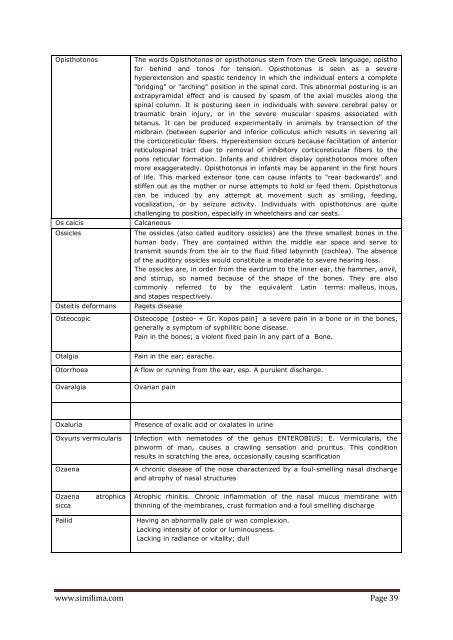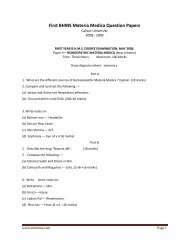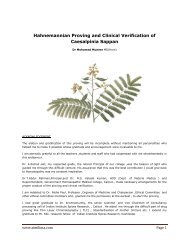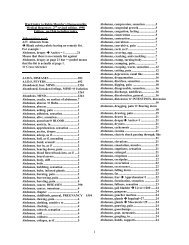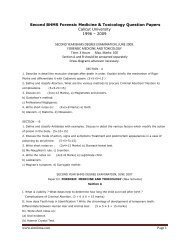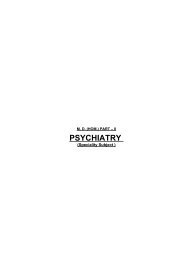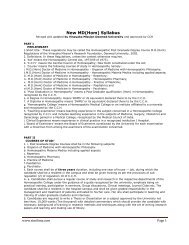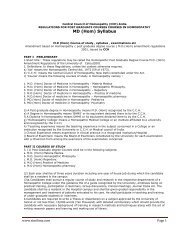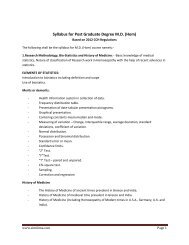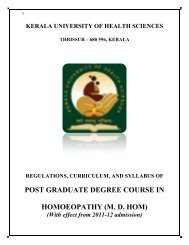Denotations & Old terminologies used in Homopathy - Similima
Denotations & Old terminologies used in Homopathy - Similima
Denotations & Old terminologies used in Homopathy - Similima
Create successful ePaper yourself
Turn your PDF publications into a flip-book with our unique Google optimized e-Paper software.
Opisthotonos The words Opisthotonos or opisthotonus stem from the Greek language, opistho<br />
for beh<strong>in</strong>d and tonos for tension. Opisthotonus is seen as a severe<br />
hyperextension and spastic tendency <strong>in</strong> which the <strong>in</strong>dividual enters a complete<br />
"bridg<strong>in</strong>g" or "arch<strong>in</strong>g" position <strong>in</strong> the sp<strong>in</strong>al cord. This abnormal postur<strong>in</strong>g is an<br />
extrapyramidal effect and is ca<strong>used</strong> by spasm of the axial muscles along the<br />
sp<strong>in</strong>al column. It is postur<strong>in</strong>g seen <strong>in</strong> <strong>in</strong>dividuals with severe cerebral palsy or<br />
traumatic bra<strong>in</strong> <strong>in</strong>jury, or <strong>in</strong> the severe muscular spasms associated with<br />
tetanus. It can be produced experimentally <strong>in</strong> animals by transection of the<br />
midbra<strong>in</strong> (between superior and <strong>in</strong>ferior colliculus which results <strong>in</strong> sever<strong>in</strong>g all<br />
the corticoreticular fibers. Hyperextension occurs because facilitation of anterior<br />
reticulosp<strong>in</strong>al tract due to removal of <strong>in</strong>hibitory corticoreticular fibers to the<br />
pons reticular formation. Infants and children display opisthotonos more often<br />
more exaggeratedly. Opisthotonus <strong>in</strong> <strong>in</strong>fants may be apparent <strong>in</strong> the first hours<br />
of life. This marked extensor tone can cause <strong>in</strong>fants to "rear backwards" and<br />
stiffen out as the mother or nurse attempts to hold or feed them. Opisthotonus<br />
can be <strong>in</strong>duced by any attempt at movement such as smil<strong>in</strong>g, feed<strong>in</strong>g,<br />
vocalization, or by seizure activity. Individuals with opisthotonus are quite<br />
challeng<strong>in</strong>g to position, especially <strong>in</strong> wheelchairs and car seats.<br />
Os calcis Calcaneous<br />
Ossicles The ossicles (also called auditory ossicles) are the three smallest bones <strong>in</strong> the<br />
human body. They are conta<strong>in</strong>ed with<strong>in</strong> the middle ear space and serve to<br />
transmit sounds from the air to the fluid filled labyr<strong>in</strong>th (cochlea). The absence<br />
of the auditory ossicles would constitute a moderate to severe hear<strong>in</strong>g loss.<br />
The ossicles are, <strong>in</strong> order from the eardrum to the <strong>in</strong>ner ear, the hammer, anvil,<br />
and stirrup, so named because of the shape of the bones. They are also<br />
commonly referred to by the equivalent Lat<strong>in</strong> terms: malleus, <strong>in</strong>cus,<br />
and stapes respectively.<br />
Osteitis deformans Pagets disease<br />
Osteocopic Osteocope [osteo- + Gr. Kopos pa<strong>in</strong>] a severe pa<strong>in</strong> <strong>in</strong> a bone or <strong>in</strong> the bones,<br />
generally a symptom of syphilitic bone disease.<br />
Pa<strong>in</strong> <strong>in</strong> the bones; a violent fixed pa<strong>in</strong> <strong>in</strong> any part of a Bone.<br />
Otalgia Pa<strong>in</strong> <strong>in</strong> the ear; earache.<br />
Otorrhoea A flow or runn<strong>in</strong>g from the ear, esp. A purulent discharge.<br />
Ovaralgia Ovarian pa<strong>in</strong><br />
Oxaluria Presence of oxalic acid or oxalates <strong>in</strong> ur<strong>in</strong>e<br />
Oxyuris vermicularis Infection with nematodes of the genus ENTEROBIUS; E. Vermicularis, the<br />
p<strong>in</strong>worm of man, causes a crawl<strong>in</strong>g sensation and pruritus. This condition<br />
results <strong>in</strong> scratch<strong>in</strong>g the area, occasionally caus<strong>in</strong>g scarification<br />
Ozaena A chronic disease of the nose characterized by a foul-smell<strong>in</strong>g nasal discharge<br />
and atrophy of nasal structures<br />
Ozaena atrophica<br />
sicca<br />
Atrophic rh<strong>in</strong>itis. Chronic <strong>in</strong>flammation of the nasal mucus membrane with<br />
th<strong>in</strong>n<strong>in</strong>g of the membranes, crust formation and a foul smell<strong>in</strong>g discharge<br />
Pallid Hav<strong>in</strong>g an abnormally pale or wan complexion.<br />
Lack<strong>in</strong>g <strong>in</strong>tensity of color or lum<strong>in</strong>ousness.<br />
Lack<strong>in</strong>g <strong>in</strong> radiance or vitality; dull<br />
www.similima.com Page 39


